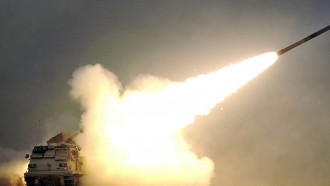Kazakhstan launched its first satellite into space on 29 April, with some help from European space agencies and manufacturers.
The KazEOSat-1 spacecraft successfully reached its intended altitude and entered orbit around the Sun. This path will keep the observatory within view of the Earth at all times. The craft will be capable of resolving objects on the surface of the Earth just three feet across.
Liftoff occurred at the European launch complex, located at Kourou, in French Guiana. A Vega rocket lifted the 1,830 pound craft to orbit.
The satellite will be used to monitor the Earth, collecting data on agricultural and natural resources. It also has the capability to assist rescue workers during disasters and create maps of changing conditions on the surface of the planet.
Average distance for the spacecraft from Earth will be 435 miles, which the satellite reached 55 minutes and 29 seconds after liftoff.
"[T]hrough our training programme, we have transferred our knowledge to the engineers from Kazakhstan who will operate the satellite, enabling Kazakhstan to control the satellite completely autonomously, and collect and use the images provided by the satellite,"saidFrançois Auque, space systems director at Airbus Defence and Space said.
Mission planners believe the spacecraft should have an operational life of around seven years.
The European Arianespace consortium managed the launch, which was the third successful liftoff for the new Vega booster rocket. This booster is small, just about 1000 feet tall while standing on the launch platform. The rocket is designed for lightweight payloads, less than 5,500 pounds.
Airbus Defence and Space manufactured the rocket, which includes a multi-satellite adapter, called Verta. This allows the rocket to deliver more than one payload per launch. On its second test mission, the rocket delivered three satellites to two separate orbits. Vega was designed by the European and Italian space agencies, with the first designs commencing in 1998. The first test flight of the three-stage rocket took place in 2012.
KazEOSat-1 was manufactured in France. It will soon be joined in orbit by a sister craft, the KazEOSat2, which is being manufactured in Britain by a subsidiary of Airbus. While the first satellite will take high-resolution photos of the planet's surface, the second craft will have a wider field of view, allowing investigators to see larger areas at one time.
"Airbus Defence and Space currently is the world's leading exporter of Earth observation satellites," the company wrote on their website.











![[LOOK] 'Twisted Metal' Video Game to Launch its First Television Series this Summer](https://1734811051.rsc.cdn77.org/data/thumbs/full/426639/295/166/50/40/look-twisted-metal-video-game-to-launch-its-first-television-series-this-summer.png)

